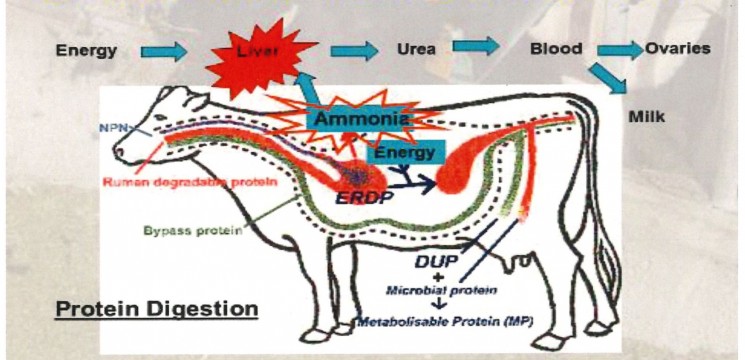News

Meeting the Cows Needs
Understanding the analysis
• The first step is to identify the cows’ allowances for energy, protein, fibre and minerals based on bodyweight and yield.
• The next step is to determine the supply of nutrients from the feeds and supplements the cows are getting
• The difference between these two is the gap which needs to be filled. The mineral/trace element gap should be filled.
ME – MJ per kgDM
- Me – Metabolisable Energy
- ME is defined as the Gross Energy (GE) of the feed less that of the faeces, urine and combustible gasses (methane)
- Feed energy is typically reported as metabolizable energy (ME). ME is a calculation derived from digestibility. There is no physical ME component in feed.
- Energy is required for al bodily functions. Energy mainly derives from carbohydrates (sugars, starches) and lipids (fats, oils), but also from protein.
- A ruminant doesn’t directly take up most of the sugars/starches in feed.
- Much of the ingested sugars and starches in feed eaten by the ruminant is utilised by the rumen microbes, rather than directly by the animal.
ME – volatile fatty acids
- In the process, rumen microbes produce substances (volatile fatty acids – VFA) that are needed by the animal an are absorbed mostly through the rumen wall.
- These substances are energy precursors for the ruminant and are used to produce glucose and fats. Thus, rumen microbial activity meets much of the ruminant’s energy needs up to 70%.
CP – Crude Protein
- Crude Protein – is estimated chemically by measuring nitrogen and is then multiplied by 6.25 to give us crude protein
- Crude Protein – is NOT true protein, true protein is made up of building blocks all amino acids.
- Effective Rumen Degradable Protein (ERDP) is the amount of dietary nitrogen (protein) which is broken down in the rumen and converted to rumen microbial protein.
- Microbial Protein (MP) is a better term to describe protein.
- DUP (bypass protein) – is the fraction of feed which has not been degraded during its passage through the rumen which is digested in the lower intestines
- Diets high in oil provide less rumen energy and reduce microbial protein production.
- DUP + MP gives us Metabolisable Protein.
Excess Nitrogen
- Over feeding of nitrogen (N) – excess N enters the blood stream as ammonia (as a toxic molecule) which is then converted to urea (not-toxic molecule) by the liver and excreted (urine) by the kidneys. This process costs energy !!
Starch
- Starch – is made from sugar units built in a complex 3-dimensional structure
- This complex structure can be opened up by heat and moisture
- Starch that have been heat treated are easier for the rumen to breakdown and ferment
- Starches from wheat and barley are fermented rapidly, and can cause rumen problems such as acidosis (fall in rumen Ph)
- Starch that is quickly fermented provides energy to the rumen microbes (Rumen Starch)
- Starch that is slowly fermented may be washed out of the rumen without being broken down by the rumen microbes provides energy to animal directly,.
Sugar
- Sugars are carbohydrates consisting of 1 or 2 units of glucose, fructose or other simple forms.
- Quickly degraded in the rumen and provide an excellent source of energy.
- Unlike starch, sugars don’t appear to lower rumen pH
- Recent research work has shown that sugars increase the yield of microbial protein
Fats and Oils
- Dietary fat is a wider term which covers various feeds with mixtures of oil or free fatty acids
- Different oil sources have different effects
- Unsaturated fats (soya, canola, fish oil) can interfere with fibre digestion
- Saturated fats (e.g. Palm Oil) have less of an effect with fibre digestion.
- Dietary oil tends to enhance milk fat % and reduce milk protein %.
FME – Fermentable Metabolisable Energy
- FME is the ME content of the feed or diet less the ME present as total oils and fats
- Dietary fats and oils, whilst highly digestible in the ruminant digestive tract cannot supply molecules of energy to the rumen microbes.
4% oil – reduces FME by 1.4Mj/kgDM
Priority of Decision Making
- Energy – amount, source
- Protein – rumen RDP, by-pass UDP
- Effective Fibre – structure
- Mineral & Vitamins – (re)production, health
- Other Factors - interactions, stress
Maximise Sustainable Production
Optimise Inputs vs Outputs
Other recent news
Milk Urea (MU)
1 August 2020
Most Dairy Companies have been giving their suppliers their herd bulk milk, Milk Urea (MU) figure for some time now. For the last few weeks MU has been available on...
Read Post
